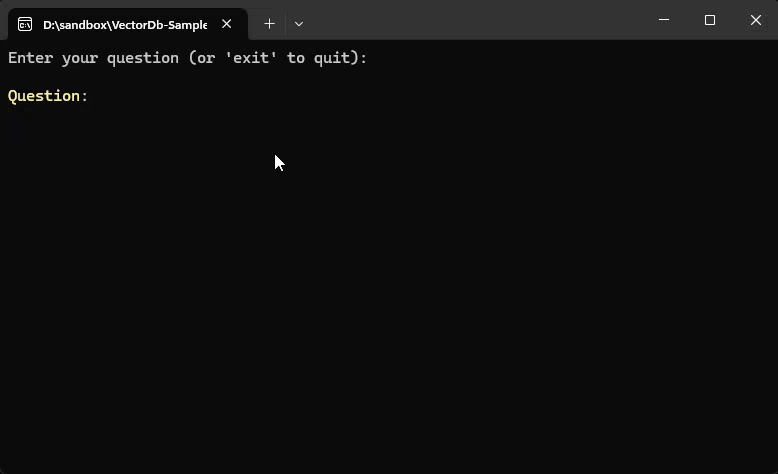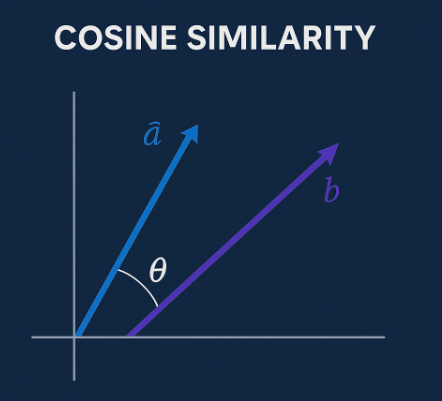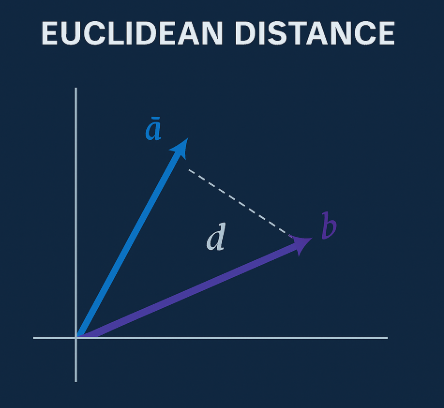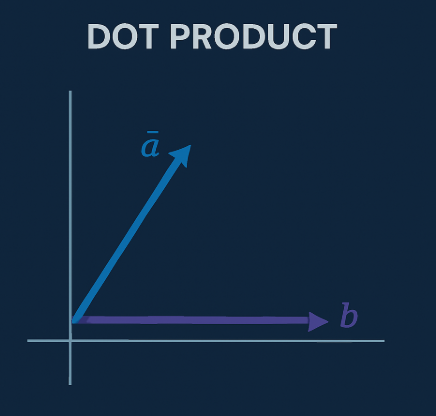Search has evolved.
We started with simple keyword search, improved it with full-text search, and are now entering the era of semantic search powered by vectors.
But here’s the reality: most software systems today are still stuck somewhere between keyword and full-text.
In this post, we’ll walk through:
- Keyword vs Full-Text vs Vector search
- Why you need vector databases — even if you already use PostgreSQL full-text search
- Similarity algorithms: cosine, dot product, Euclidean — with visuals
- A full .NET 9 RAG implementation using PostgreSQL +
pgvector+ Ollama

From Keyword to Meaning
Keyword Search: Literal Matching
You search for "user authentication".
What it does:
- Looks for those exact words in documents
- Often via
LIKE '%user%' AND LIKE '%authentication%' - Cannot handle synonyms, paraphrasing, or natural questions
It’s brittle, dumb, and blind to context.
Full-Text Search: Tokenization + Linguistic Awareness
PostgreSQL full-text search (tsvector, tsquery) improves things by introducing:
- Tokenization: Splits text into words
- Stop-word removal: Filters common words like “the”, “is”, “and”
- Stemming: Reduces words to their base or root form
What Are Word Stems?
A word stem is the core part of a word that conveys its essential meaning.
For example:
| Word | Stem |
|---|---|
| authentication | authentic |
| authenticating | authentic |
| users | user |
| validated | valid |
| validation | valid |
This means that a search for "authenticate" will also match documents containing:
"authentication""authenticating""authenticated"
…because they share the same stem.
PostgreSQL does this using language-specific dictionaries (e.g., English, Turkish), making it far more effective than naive string matching.
But even full-text search has limits:
It understands words, but not ideas.
So it still can’t match "credential check" or "login mechanism" for "user authentication" — even though a human immediately sees the connection.
That’s Why We Need Vector Search
Vector search goes beyond stems. It embeds entire sentences or paragraphs into numeric space that captures semantics — meaning, context, tone, and relationships.
No tokenization, no word lookup, no stemming.
Just meaning → numbers → proximity.
Similarity Algorithms (with Visuals)
Vectors are just points in space. To compare them, we measure how close or aligned they are.
1. Cosine Similarity (Angle-Based)
- Measures the angle between vectors.
cos(a, b) = angle between a and b
- Ignores magnitude — it doesn’t care if vectors are “long” or “short”.
-
Perfect for text, where relative direction matters more than absolute values.

2. Euclidean Distance (L2)
- Straight-line (Pythagorean) distance between two points.
-
Sensitive to magnitude — vectors that are longer (i.e., have higher norm) appear farther away.
The magnitude of a vector is its length:
v = sqrt(v₁² + v₂² + … + vₙ²)
-
Think of it as the distance from the origin. Vectors with similar direction but different magnitude may still represent the same concept.

3. Dot Product
- Gives high values when vectors point in the same direction and are large.
same direction = high dot product
-
Useful when you want to combine direction and strength (used in LLM ranking models)

Summary of Distance Functions
| Metric | Operator in pgvector | Best Use Case |
|---|---|---|
| Cosine similarity | <=> |
Text search, embeddings |
| Euclidean (L2) | <-> |
Geometry, metrics |
| Dot product | <#> |
Ranking, hybrid scoring |
What Is a Vector Database?
A vector database:
- Stores high-dimensional embeddings
- Supports similarity search
- Often supports metadata filtering
- May implement Approximate Nearest Neighbor (ANN) techniques for performance
Popular Vector Databases
| Name | Description |
|---|---|
| Faiss | High-speed ANN by Meta, great for local indexing with GPU support |
| Qdrant | Rust-based, with filtering and payload support, cloud-native or local |
| Weaviate | Graph + vector hybrid search with a strong schema and type system |
| Milvus | Designed for massive-scale vector search, highly optimized |
| Chroma | Lightweight, Python-first, often used in LLM pipelines |
| Pinecone | Fully managed SaaS with filtering, scaling, and hybrid keyword search |
Why pgvector?
The pgvector extension brings vector search capabilities directly into PostgreSQL.
Why use it?
- You’re already using PostgreSQL
- You need transactional consistency
- You want to simplify infrastructure
- You want to use raw SQL or EF Core alongside embeddings
It turns PostgreSQL into a hybrid data+vector engine with one simple line:
CREATE EXTENSION IF NOT EXISTS vector;
Implementing Semantic Search in .NET with pgvector
We’ll build a Retrieval-Augmented Generation (RAG) flow that:
- Embeds your documents using Ollama
- Stores them in PostgreSQL
- Accepts a user query
- Embeds the query and finds relevant docs
- Composes a final prompt to send to the LLM
Source Code is available on GitHub
The Sample Use Case
Our sample use case is to create an assitan that can answer questions about KUKA robot messages.
For preperation, we will use the following JSON file as our document source. The json content was constructor from a PDF file
Please refer to \VectorDb-Sample\VectorSample.KukaPdfToJsonCli\VectorSample.KukaPdfToJsonCli.csproj for the full code.
[
{
"Code": 1,
"Title": "EMERGENCY STOP",
"Cause": "EMERGENCY STOP button pressed.\r\nEMERGENCY STOP circuit broken.\r\nEMERGENCY STOP triggered by program.",
"Effect": "Path--maintaining braking.\r\nAll active commands inhibited.",
"Remedy": "Release the EMERGENCY STOP pushbutton.\r\nCheck EMERGENCY STOP pushbutton and EMERGENCY STOP cir-\r\ncuit.\r\nRectify and acknowledge the signalled fault."
},
{
"Code": 2,
"Title": "Internal error",
"Cause": "Internal test of KRC software.",
"Effect": "Ramp--down braking.\r\nAll active commands inhibited.",
"Remedy": "Acknowledge message."
}
]
1. PostgreSQL Setup
We will use the official pgvector Docker image for PostgreSQL 17.
Below is the docker-compose file. Save the file as docker-compose.yml to your project root.
```yaml
version: "3.8"
services:
postgres:
image: pgvector/pgvector:pg17
container_name: pgvector
ports:
- "54321:5432"
environment:
POSTGRES_USER: admin
POSTGRES_PASSWORD: admin
POSTGRES_DB: vectordb
volumes:
- pgdata:/var/lib/postgresql/data
volumes:
pgdata:
The run it with
docker-compose up -d
Create pgvector extension in PostgreSQL. This is done by running the following SQL command in your PostgreSQL client (e.g., psql, DBeaver, etc.).
NOTE: You will need to run this command on the
vectordbdatabase.
CREATE EXTENSION IF NOT EXISTS vector;
Then create the documents table with the following SQL command:
CREATE TABLE documents (
id UUID PRIMARY KEY,
content TEXT NOT NULL,
embedding VECTOR(768),
metadata JSONB
);
CREATE INDEX ON documents USING ivfflat (embedding vector_cosine_ops) WITH (lists = 100);
2. Embedding with Ollama
We will use nomic-embed-text model from Ollama to generate embeddings. This model generates 768-dimensional vectors.
// File: VectorSample.EmbeddingServices\OllamaEmbeddingClient.cs
public class OllamaEmbeddingClient: IDisposable
{
private readonly HttpClient _http = new();
private OllamaEmbeddingClientOptions _options;
private string _model;
private Uri _embedUri;
public OllamaEmbeddingClient(OllamaEmbeddingClientOptions options)
{
_options = options;
_model = _options.Model;
var baseUri = new Uri(_options.BaseUrl);
_embedUri = new Uri(baseUri,"api/embed");
}
public async Task<float[]> GetEmbeddingAsync(string text)
{
var request = new { model = _model, input = $"{text}" };
var response = await _http.PostAsJsonAsync(_embedUri, request);
var result = await response.Content.ReadFromJsonAsync<EmbeddingResponse>();
return result?.Embeddings?.FirstOrDefault()?.ToArray() ?? throw new Exception("No embedding returned");
}
public void Dispose()
{
_http?.Dispose();
}
}
3. Store Embedded Documents
// File: VectorSample.Database\VectorStore.cs
public async Task StoreDocumentAsync(string content, float[] vector, IDictionary<string, string> metadata)
{
var dataSourceBuilder = new NpgsqlDataSourceBuilder(_connStr);
dataSourceBuilder.UseVector();
await using var dataSource = dataSourceBuilder.Build();
using var conn = dataSource.CreateConnection();
try
{
await conn.OpenAsync();
await using var cmd = new NpgsqlCommand("""
INSERT INTO documents (id, content, embedding, metadata)
VALUES (@id, @content, @embedding, @metadata)
""", conn);
cmd.Parameters.AddWithValue("id", Guid.NewGuid());
cmd.Parameters.AddWithValue("content", content);
cmd.Parameters.AddWithValue("embedding", vector);
// Properly defined JSONB param
cmd.Parameters.Add(new NpgsqlParameter("metadata", JsonSerializer.Serialize(metadata))
{
NpgsqlDbType = NpgsqlDbType.Jsonb
});
await cmd.ExecuteNonQueryAsync();
}
finally
{
await conn.CloseAsync();
}
}
4. Search with Cosine Similarity
// File: VectorSample.Database\VectorStore.cs
public async Task<List<string>> SearchAsync(float[] queryVector,int topK = 5)
{
var dataSourceBuilder = new NpgsqlDataSourceBuilder(_connStr);
dataSourceBuilder.UseVector();
await using var dataSource = dataSourceBuilder.Build();
var vector = new Pgvector.Vector(queryVector);
using var conn = dataSource.CreateConnection();
try
{
await conn.OpenAsync();
await using var cmd = new NpgsqlCommand("""
SELECT
content
FROM documents
ORDER BY embedding <=> @embedding
LIMIT @topK
""", conn);
cmd.Parameters.AddWithValue("embedding", vector);
cmd.Parameters.AddWithValue("topK", topK);
var results = new List<string>();
var reader = await cmd.ExecuteReaderAsync();
while (await reader.ReadAsync())
results.Add(reader.GetString(0));
return results;
}
finally
{
await conn.CloseAsync();
}
}
5. RAG Prompt Composition
// File: VectorDb-Sample\VectorSample.RagCli\Program.cs
internal class Program
{
private static string _connectionString = "Host=localhost;Port=54321;Username=admin;Password=admin;Database=vectordb";
private static string _chatModel = "phi4";
private static string _embedModel = "nomic-embed-text";
private static string _ollamaUrl = "http://localhost:11434";
static async Task Main(string[] args)
{
using var vectorStore = new VectorStore(new(_connectionString));
using var chatClient = new OllamaChatClient(new(_ollamaUrl, _chatModel));
using var embeddingClient = new OllamaEmbeddingClient(new(_ollamaUrl, _embedModel));
Console.WriteLine("Enter your question (or 'exit' to quit):");
while (true)
{
var firstChunkArrived = false;
var spinnerFinished = false;
Console.WriteLine();
var question = AnsiConsole.Prompt(
new TextPrompt<string>("[bold yellow]Question[/]:").AllowEmpty());
if (string.Equals(question, "exit", StringComparison.OrdinalIgnoreCase))
break;
List<string> topDocs = new();
StatusContext statusContext = null!;
var _ = AnsiConsole.Status()
.Spinner(Spinner.Known.Star)
.StartAsync("Thinking...", async ctx => {
statusContext = ctx;
while (!firstChunkArrived)
{
await Task.Delay(100);
}
ctx.Status("Done Thinking");
ctx.Refresh();
spinnerFinished = true;
return;
});
statusContext.Status("Generating embedding...");
statusContext.Refresh();
var questionVector = await embeddingClient.GetEmbeddingAsync(question);
statusContext.Status("Searching vector store...");
statusContext.Refresh();
topDocs = await vectorStore.SearchAsync(questionVector, 5);
statusContext.Status("Thinking...");
statusContext.Refresh();
var prompt = $"""
You are a helpful assistant. Use the following documents to answer the question.
Documents:
{string.Join("\n---\n", topDocs)}
Question: {question}
Answer:
""";
try
{
await foreach (var response in chatClient.ChatAsync(question, systemPrompt: prompt))
{
if (!firstChunkArrived)
{
AnsiConsole.MarkupLine("[bold blue]Response:[/]");
firstChunkArrived = true;
}
while (!spinnerFinished)
{
await Task.Delay(100);
}
Console.Write($"{response}");
}
}
catch(Exception ex)
{
firstChunkArrived = true;
while (!spinnerFinished)
{
await Task.Delay(100);
}
AnsiConsole.MarkupLine($"[red]Error:{Markup.Escape(ex.Message)}[/]");
}
Console.WriteLine();
}
}
}
When to Use What?
| Technique | Good For |
|---|---|
| Keyword search | Simple literal matching, filtering by ID |
| Full-text search | Exact phrasing + language stem detection |
| Vector search | Semantic intent, LLMs, paraphrased content |
| Hybrid (fts+vec) | Best of both worlds in enterprise scenarios |
Real-World Scenarios
-
Search support tickets by meaning: “SSL handshake error” → matches “TLS cert failure”
-
Legal clause discovery: “Termination without notice” → matches “Immediate cancellation clause”
-
Developer tools: “Thread-safe list” → finds ConcurrentQueue docs
-
IIoT logs: “Spindle vibration high” → matches “Abnormal RPM readings”
Final Thoughts
Vector databases give us a semantic lens into unstructured data.
PostgreSQL + pgvector is all you need to build powerful semantic apps — in a single stack, with transactional safety, and full .NET integration.
You’re not locked into Pinecone, Chroma, or Faiss. You can do it all — right inside your existing PostgreSQL instance.
References
Bu yazıyı beğendiyseniz Twitter’da takipçilerinizle paylaşabilir veya beni Twitter’da takip edebilirsiniz.